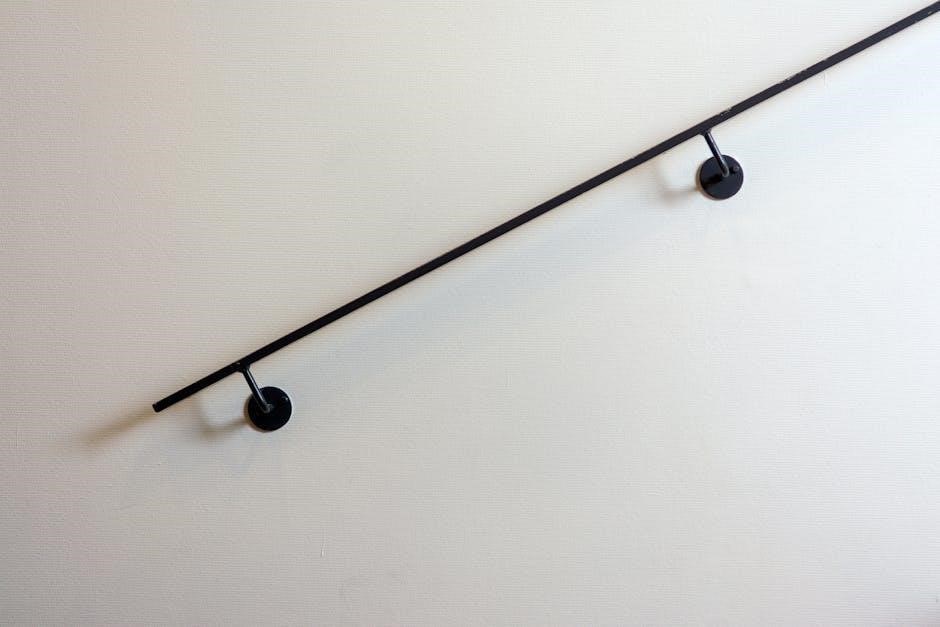Discover the essential steps and safety tips for installing a TV wall mount. This guide provides a comprehensive overview, ensuring a secure and stylish setup for your TV.
1.1 Benefits of Wall Mounting Your TV
Wall mounting your TV offers numerous benefits, including space-saving, improved aesthetics, and enhanced viewing angles. It also reduces glare, keeps cables organized, and ensures better safety by preventing tip-overs. Additionally, it maximizes room layout flexibility and provides a sleek, modern appearance. Proper installation ensures stability and supports the weight of your TV securely, making it a practical and stylish solution for any home or office setup.
1.2 Importance of Proper Installation
Proper installation ensures your TV is securely mounted, preventing damage or injury from falls. It guarantees optimal viewing angles and stability, reducing the risk of equipment failure. Correctly following installation steps also preserves the TV’s warranty. A well-executed setup enhances durability and safety, providing peace of mind and a professional finish to your home entertainment system.
Choosing the Right TV Wall Mount
Selecting the correct TV wall mount is crucial for safety and functionality. Consider weight capacity, VESA pattern compatibility, and desired mobility to ensure a stable and secure installation.
2.1 Types of TV Wall Mounts (Fixed, Tilting, Swivel, Full Motion)
TV wall mounts come in four main types: Fixed, Tilting, Swivel, and Full Motion. Fixed mounts hold the TV flat against the wall, while Tilting mounts allow angle adjustments. Swivel mounts enable side-to-side movement, and Full Motion mounts offer tilt, swivel, and extension for maximum flexibility. Choose the type that best suits your viewing needs and room layout for optimal functionality.
2.2 Weight and Size Considerations for Mount Selection
When selecting a TV wall mount, consider the TV’s weight and size. Ensure the mount supports the TV’s weight and is compatible with its screen size. Check the VESA mounting pattern to confirm compatibility. The wall must support five times the combined weight of the TV and mount. Always verify specifications against the TV’s manual for a secure installation.

Preparing for Installation
Gather necessary tools, prepare the TV, and review the manual to ensure a smooth installation process. Check weight capacity and organize parts for efficiency.
3.1 Essential Tools and Equipment Needed
Gather a stud finder, drill, level, screwdrivers, wrench, lag bolts, wall anchors, and mounting hardware. Ensure you have a pencil for marking and a ladder for safe access. Verify all tools match the mounting kit specifications to avoid installation issues. Organize parts and instructions for efficiency, ensuring compatibility with your TV and wall type.
3.2 Preparing the TV and Mounting Hardware
Lay the TV face down on a soft surface to prevent damage. Separate the mount components, ensuring all parts are included. Attach the brackets to the TV using the appropriate screws, matching the VESA pattern. Double-check compatibility and tighten securely. Prepare the wall plate and hardware, ensuring all bolts and anchors are ready for installation. Follow the manufacturer’s instructions precisely for a safe setup.

Understanding Your Wall Structure
Identify your wall type (drywall, wood stud, concrete, or brick) and assess its weight capacity. Ensure it can support five times the TV’s weight plus the mount. Locating wall studs is crucial for wood walls to ensure stability and secure installation.
4.1 Identifying Wall Types (Drywall, Wood Stud, Concrete, Brick)
Drywall requires anchors for support, while wood stud walls need studs located for secure mounting. Concrete and brick walls demand specialized drill bits and anchor systems. Each wall type has unique requirements to ensure stability and safety during installation, preventing potential damage or hazards. Proper identification is key to a successful setup.
4.2 Assessing Wall Weight Limits and Stability
Ensure your wall can support at least five times the combined weight of the TV and mount. Verify structural integrity by checking for studs in wood walls or using anchors in concrete or brick. Avoid drywall-only installation without proper support. Stability is crucial to prevent damage or safety hazards, ensuring a secure and lasting setup. Always test weight limits before finalizing the installation.
Installing the Wall Plate
Position the wall plate accurately, ensuring it is level and aligned with the TV’s mounting pattern. Secure it using appropriate anchors or lag bolts for stability and safety.
5.1 Step-by-Step Guide to Wall Plate Installation
Begin by locating wall studs or suitable fixing points. Mark the wall for pilot holes, ensuring alignment with the TV’s VESA pattern. Drill holes, insert anchors, and attach the wall plate using lag bolts. Tighten securely to ensure stability. For concrete or brick walls, use appropriate fasteners to support the weight safely and prevent damage.
5.2 Securing the Wall Plate to Different Wall Types
For wood stud walls, drill pilot holes and use lag bolts. On concrete or brick, use anchor kits to ensure a secure hold. Drywall requires sturdy anchors to prevent collapse. Always check weight limits and ensure the wall plate is level; Use appropriate fasteners for each wall type to guarantee stability and safety, following manufacturer guidelines for optimal results.

Attaching the TV Bracket
Attach the TV bracket securely to the back of your TV, ensuring proper alignment with the VESA pattern. Use spacers if necessary for flat-back TVs and ensure it’s level.
6.1 Mounting the Bracket to the TV
Place the TV face down on a soft surface. Attach the bracket to the TV’s back, aligning it with the VESA mounting holes. Use spacers if necessary for flat-back TVs. Ensure the bracket is centered and level. Tighten the screws firmly but avoid over-tightening to prevent damage. Double-check compatibility before securing to ensure a stable fit.
6.2 Aligning the TV Bracket with the Wall Plate
Place the TV face down on a soft surface. Align the TV bracket with the wall plate, ensuring hooks or mounting holes match perfectly. Use Velcro straps to manage cables. Carefully lift the TV and hook it onto the wall plate. Tighten screws to secure it firmly. Double-check alignment and stability before releasing the TV to ensure a proper fit.

Hanging the TV on the Wall
Lift the TV carefully, ensuring it’s balanced. Attach it to the wall plate, checking stability. Ensure proper alignment and secure the TV firmly to the mount for safety.
7.1 Safely Lifting and Attaching the TV
Lift the TV with at least two people to ensure balance and control. Place the TV face down on a soft, flat surface. Align the TV brackets with the wall plate, ensuring proper connection. Secure the TV firmly to the mount, tightening all bolts gently. Double-check the weight limits and stability before releasing the TV to avoid accidents.
7.2 Ensuring Proper Balance and Leveling
Use a spirit level to ensure the TV is perfectly horizontal and vertical. Adjust the mount as needed to achieve balance. Check stability by gently rocking the TV side to side. Ensure all bolts are tightened securely to prevent movement. Verify the TV’s weight is evenly distributed to maintain proper leveling and avoid any wobbling or tilting over time.
Managing Cables and Wires
Organize cables neatly using cable ties or Velcro straps. Conceal wires behind the wall or within cable management boxes for a clean, professional appearance. Ensure all connections are secure and labeled for easy access. Proper cable management enhances safety, reduces clutter, and improves the overall installation aesthetics. Use cable clips to route wires neatly.
8.1 Tips for Concealing Cables
Organize cables neatly using cable ties or Velcro straps. Conceal wires behind the wall or within cable management boxes. Route cables through clips or channels to keep them tidy. Ensure all connections are secure and labeled for easy access. Properly conceal cables to enhance safety, reduce clutter, and improve the installation’s aesthetic appeal. This step ensures a clean and professional finish to your TV setup.
8.2 Using Cable Management Tools
Utilize cable ties, Velcro straps, or cable clips to organize wires securely. Route cables through wall channels or adhesive-backed cable tracks for a neat appearance. Secure all connections tightly to prevent loose wires. Use cable management boxes to store excess cable lengths. These tools ensure cables remain hidden, reducing clutter and enhancing the overall installation’s safety and visual appeal.
Testing and Adjustments
Check the mount’s stability, tighten any loose bolts, and ensure the TV is level. Adjust the TV’s position for optimal viewing angle and verify all connections for long-term stability.
9.1 Testing the Stability of the Mount
Ensure the wall plate is securely fastened and level. Gently rock the TV from side to side to verify the mount’s stability. Check for any wobbling or movement, which may indicate loose bolts or improper installation. If the mount feels unstable, tighten all connections and retest. A stable mount is crucial for preventing damage or potential hazards.
9.2 Adjusting the TV Position for Optimal Viewing
Once installed, adjust the TV’s position for the best viewing experience. Tilt, swivel, or rotate the screen to eliminate glare and ensure a clear view from all angles. Use a leveling tool to align the TV horizontally. Test different positions and secure the mount to maintain stability. Proper adjustment enhances both visual quality and ergonomic comfort for viewers.
Common Installation Issues and Solutions
Address common issues like loose mounts or uneven alignment by tightening bolts and verifying weight limits. Consult professionals if problems persist for a secure setup.
10.1 Troubleshooting Common Problems
Common issues include loose mounts, uneven alignment, or insufficient wall support. Check weight limits, tighten bolts, and ensure proper wall anchor installation. If instability persists, verify VESA compatibility and consult professional help to avoid damage or safety risks.
10.2 Addressing Weight and Balance Concerns
Ensure the wall mount supports the TV’s weight by verifying weight limits and using appropriate hardware. For wood studs, use lag bolts with anchors, while concrete requires expansion anchors. Hang the TV slightly lower for better balance and stability. Always double-check weight distribution to prevent tilting or shifting, ensuring a secure installation.
Safety Precautions
Always ensure the wall mount supports five times the TV’s weight. Use proper fasteners and check weight limits to avoid damage or injury. Secure the mount tightly.
11.1 General Safety Guidelines
Always follow safety guidelines to prevent accidents. Use appropriate fasteners and ensure the wall mount supports five times the TV’s weight. Avoid over-tightening screws, as this may damage the TV or wall. Keep the installation area clear of clutter and have someone assist with lifting heavy TVs. Consult a professional if unsure about any step.
11.2 Avoiding Common Safety Hazards
- Avoid using improper fasteners, as they may fail under weight.
- Ensure the wall can support five times the TV’s weight to prevent collapse.
- Keep power cords away from mounting brackets to avoid pinching.
- Never install on drywall alone; use anchors for stability.
- Do not mount on ceilings unless specified in the manual.
- Avoid over-tightening screws to prevent damage to the TV or wall.
Final Checks and Completion
Ensure all connections are secure and the TV is level. Verify stability, tighten any loose parts, and confirm proper weight distribution. Installation is now complete and safe for use.
12.1 Verifying All Connections and Stability
After installation, check all bolts and screws for tightness. Ensure the mount is firmly attached to the wall and the TV is securely fastened. Test stability by gently rocking the TV side-to-side and front-to-back. Verify that all cables are neatly concealed and not pinched. Confirm the TV is level using a spirit level for optimal viewing and safety.
12.2 Finalizing the Installation
Once all connections are secure, double-check the TV’s alignment and ensure it is perfectly level. Tighten any remaining bolts and verify that all components are firmly in place. Conceal any exposed cables for a clean look and ensure no wires are pinched. Finally, test the TV’s position and adjust as needed for optimal viewing. Ensure all safety standards are met before finalizing.
Thank you for following this guide. Proper installation ensures safety, stability, and optimal viewing. Always follow safety guidelines and enjoy your perfectly mounted TV setup.
13.1 Summary of Key Installation Steps
Mounting your TV involves selecting the right mount, preparing tools, and ensuring wall stability. Attach the bracket to the TV, secure the wall plate, and carefully hang the TV. Conceal cables for a neat look and test stability. Follow safety guidelines to avoid damage or injury, ensuring a successful installation.
13.2 Maintenance Tips for Long-Term Stability
Regularly inspect the mount and TV connections to ensure tightness. Clean dust from cables and brackets for optimal performance. Check for loose bolts and tighten as needed. Avoid harsh chemicals when cleaning the TV or mount. Periodically verify the weight distribution and balance for stability. Ensure cables remain securely managed to prevent damage or tangling over time.
